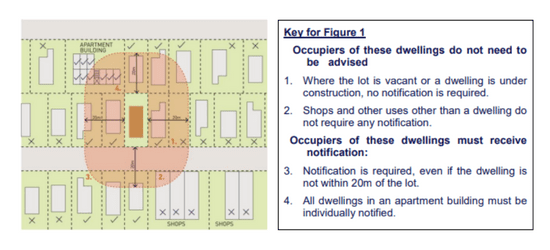KEY TAKE-OUTS
Complying Development Certificate applications do not require a development application approved by Council and can be made for:
- A new dwelling house, including additions to an existing dwelling;
- Demolition of a building under the relevant SEPP;
- A secondary dwelling or a group home under the Affordable Housing SEPP.
If you are the neighbour:
- What is the process?
- What rights do you have when you receive notice of a Complying Development?
We take a look at what is complying development and what are your rights if your neighbour proposed to seek a complying development certificate for building their home, renovations or other development.
What does a complying development mean?
Complying development is a development that meets a set of specified standards and as a result, does not need Council approval. An example of complying development is the erection of a new 1- or 2-storey dwelling house built in accordance with all the requirements of the Housing Code.
What is required for complying development?
The standards for complying with development address matters such as height of building, setbacks, car parking and access requirements, landscaping, fences, retaining walls and balconies, and privacy screens.
Do neighbours get notified of CDC?
When a Complying Development Certificate (CDC) is applied for there are two stages of notification for neighbouring properties. They are:
- Pre-Determination Notification; and
- Pre-Commencement Notification.
Once you receive a notification, knowing what to do next can be a little tricky but read on.
CDC Notification requirements
When is a CDC Pre-determination Notification required?
When a Complying Development Certificate application (CDC application) is made, the occupier of each dwelling within 20 metres of the boundary of the proposed development must be given notice. The zone of influence under the 20-metre requirement is demonstrated below.

The Environmental Planning and Assessment Regulation 2000 (the Regulation) requires that notice of a CDC application must be given to neighbours 14 days prior to the approval of the CDC by the certifying authority. The certifying authority can be a private certifier or council, and the relevant certifying authority will issue notice of the CDC application to the neighbours.
When is a CDC Pre-commencement Notification required?
When a CDC is issued by a certifying authority, the Regulation requires the conditions of the CDC to include that the owner of the subject property (the person receiving the benefit of the application) must notify the occupiers of neighbouring properties that they intend to commence works.
The relevant occupiers are those that occupy the properties within the zone of influence as noted above. The condition of the CDC must require that the notice is to be given, to a maximum of:
- Seven days prior to the commencement of work; and
- No less than two days prior to the commencement of work.
What can you do once you receive a Pre-Determination Notice of a CDC application?
It is important to note that, unlike in relation to a development application lodged with Council, in the normal course neighbours are not invited to make submissions and have no right of appeal complying development. This means as the owner of a neighbouring property, you have no right to object to the proposed development and there is no obligation on the certifying authority to consider your submissions.
The NSW Department of Planning notes that the pre-determination notification is for the advice of the neighbouring owners. The intention of this process is to put an emphasis on neighbourly conversation, in that the owner of the subject property would consult their neighbours prior to lodgement of the CDC application.
Can you object to a CDC?
When making submissions, the grounds for objection should focus on the proposal’s compliance with the Housing Code for the relevant type of development.
Focusing on the visual impact, for example, is not a sufficient ground for objection to the development overall.
Can a neighbour object to permitted development?
Unlike a development application lodged with Council where there are legal avenues for appeal, neighbouring properties have limited recourse to address development that has been certified to comply and a CDC has been issued.
If you believe the development does not comply, raise the issue with the certifier who issued the CDC at first instance and also ensure they are accredited. Talking through the issue with the certifier first will give them an opportunity to consider your concerns and what action they may take to resolve it.
If the certifier does not agree with you but you still think there has been an error, you can also make a complaint about the certifier to the Building Professionals Board. It is necessary to have evidence to prove the certifier has made an error and should not have issued the CDC.
There are also technical legal avenues to challenge the validity of a CDC if issued in error, however, we always recommend trying to resolve issues with your neighbour and the certifier first before considering proceedings, which are both costly and time-consuming and a drain on the emotional as well a financial resources.
Useful links
- Planning Approval Pathways – Complying Development
- Development Assessment – The Codes SEPP
- Housing SEPP
- Oatley man’s $100k legal battle over neighbour’s pool deck
For further information please don’t hesitate to contact our Sydney Lawyers at Coutts Lawyers.
This blog is merely general and non-specific information on the subject matter and is not and should not be considered or relied on as legal advice. Coutts is not responsible for any cost, expense, loss or liability whatsoever to this blog, including all or any reliance on this blog or use or application of this blog by you.



